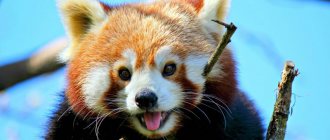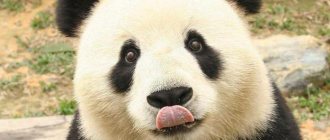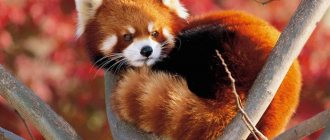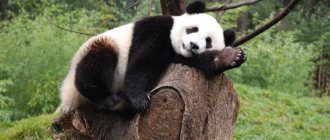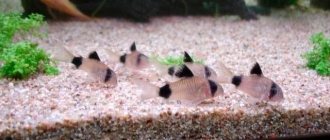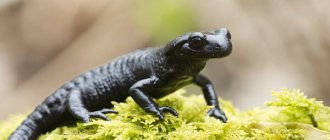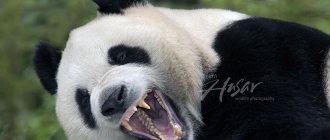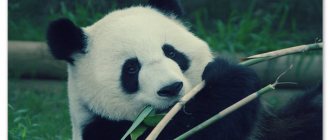From January 18, 2022, a promotion with cashback from Rostourism and the Mir card begins.
It will last until April 12, 2022. The rules are simple: a tourist who pays for a trip within the country with a Mir card receives a cashback of 20% of the cost of the tour or accommodation.Travel systems participating in the promotion and detailed description:
- Tours: Big Country
- Sanatoriums: Putyovka.com
- Tour operators: TUI Russia
The red panda, sometimes called the red panda or the fire fox, bears little resemblance to its larger cousin. However, this does not make the animal any less interesting. It is at least curious that the red panda leads an exclusively twilight lifestyle. In our article we present to your attention seven more interesting facts about this amazing animal.
Perfect camouflage from nature
Red pandas can be easily identified by their unique reddish coat color. This coloration acts as camouflage in the crowns of spruce trees, whose branches are covered with reddish-brown moss and white lichen.
They have large, round heads and short snouts with large, pointed ears. Their faces are white with reddish-brown "tear-tear" markings that extend from the eyes to the corners of the mouth. These markings protect the animals' eyes from sunlight. Their tails have alternating red and yellowish rings.
Appearance and features
Photo: Animal red panda
The appearance of the red panda is so charming that you want to admire it again and again. Its dimensions are comparable to those of a very well-fed Pallas cat. The red panda weighs from 4 to 6 kg, body length varies from half a meter to 64 cm, not counting the luxurious tail, which is almost the same length as the body size and reaches half a meter. By sight it is impossible to distinguish who is in front of you: a female or a male, they are the same. The body of the red panda is slightly elongated, like that of the mustelidae family.
The head is large, wide with a pointed muzzle. Panda ears resemble those of a cat. The panda's eyes are small and black. The rich fluffy tail is decorated with transverse stripes of a lighter tone, and the tail tassel is black.
The paws of the “fire fox” are stocky, short, powerful with sharp and hook-shaped claws that help deftly conquer any trees. The base of the feet is made of wool, which is very comfortable when walking on snowdrifts and ice. In addition to the usual five toes, the sixth is located a little higher on the paw; it helps to hold the bamboo branches.
You can envy the red panda's fur coat and its coloring; it is so magnificent that you can't take your eyes off it! The animal's fur is very soft, silky, thick and quite long, so the figure looks well-fed. The coloring of the animals is very unusual: the back is colored either chocolate-red or fiery red. The abdomen is brown with reddish streaks or completely black. The ends of the hair on the back are yellow, the paws of the red panda are fluffy, black, shimmering with shine.
The muzzle and ears stand out in contrast on the red head, thanks to the white color. Near the eyes there is something like a mask, like a raccoon. The tip of a panda's nose is black. The red panda's tail is also red with a dozen rings of a lighter color.
It would seem, why does the animal need such a bright and attention-grabbing color? The answer is simple - it all depends on the area where the animal lives. Most of the time, the red panda is on trees that are covered with all kinds of lichens and mosses of a red hue, so in such an environment the panda’s colors do not seem provocative, but, on the contrary, help it to camouflage well.
Carnivorous picky eaters
Photo: GETTY IMAGES
Bamboo makes up about 95% of the red panda's diet. Unlike giant pandas, which eat almost all of the aboveground part of the bamboo (including the stem), red pandas selectively feed on the most nutritious leaf tips and, if possible, tender shoots. Like their giant cousins, red pandas grab plant stems with their front paws and cut leaves with their mouths.
Unlike other carnivores their size, red pandas have extremely strong teeth. They have the stomach of a carnivore, despite their predominantly leafy diet. They can add roots, succulent grasses, fruits, insects, larvae, birds and small mammals to their diet. At zoos they get apples, grapes, bananas, blueberries and other vitamin-fortified treats.
National emblem of China
Giant pandas can be seen in China (as well as Tibet), mainly in mountainous regions. This huge animal (reaches approximately 1.5 meters in length and weighs up to 160 kg) is a kind of symbol of China . There, pandas became sacred animals - in Ancient China, for example, their faces were minted on gold coins, and now, as a sign of special respect, they are used as the most expensive diplomatic gifts.
In China, there is a special panda reserve, where experts in their field study and breed this unique animal.
The Last of the Mohicans
Red pandas are the only living member of the family Ailuridae, and their taxonomic position has long been the subject of scientific debate. They were first described as members of the raccoon family (Procyonidae) - a controversial classification - in 1825 due to ecological characteristics and morphological similarities of the head, dentition and ringed tail. Later, due to some DNA similarities, they were assigned to the bear family (Ursidae).
However, the most recent genetic study places red pandas in a separate, independent family: Ailuridae. Molecular phylogenetic studies indicate that red pandas are an ancient species of the order Carnivora (superfamily Musteloidea) and are probably most closely related to the group that includes skunks, raccoons and weasels.
New genetic studies have also identified two different species of red panda: Ailurus fulgens fulgens and Ailurus fulgens styani. The latter is usually larger and has a deeper red color than the former.
Photo: Mark Dumont/Flickr
Red pandas are crepuscular animals
They are most active at dawn and dusk. On average, they spend about 45% of the day without sleeping and tend to be more active in cool weather, especially during the winter mating season.
In very cold temperatures, red pandas can remain inactive, lowering their metabolic rate and increasing it every few hours when they wake up in search of food. Minimal energy expenditure is very beneficial given the low nutritional value of the red panda's diet.
To retain body heat and reduce energy consumption in the cold, they additionally curl into a tight ball. Conversely, when it is warm outside, red pandas stretch out on branches and pant to lower their body temperature.
Loners in life
Red pandas are solitary except during breeding season. In a zoo setting, most breeding pairs live together year-round. In the wild, the habitat of one animal is about 2.5 square meters. km.
Photo: www.marwell.org.uk
Red pandas are generally quiet, but muffled sounds such as squeals, chirps and snorts can be heard in close proximity. They may also hiss or grunt, and the young use a whistle or high-pitched bleat to make a distress signal.
Feeding the beast
Although the small panda is classified as a predator, in fact its diet is dominated by plant foods. Rather, they were nicknamed predators because of their specific digestive system, rather than their gastronomic preferences. The animal's favorite food is young bamboo and juicy berries. And only five percent of the total diet is animal food, such as:
- rodents;
- bird eggs;
- small animals.
As you can see, small animals have a fairly low-calorie diet, and that is why they need about two kilograms of food per day to fully provide their body with nutrients.
If the animal eats only bamboo, then it will need more than four kilograms of such food per day. to eat this much food, so the animal spends almost its entire day chewing.
In an artificial environment where pandas are kept, they are fed cereals and milk. They do this in order to increase the daily caloric intake of food consumed. It is worth saying that the panda has a rather specific diet , so keeping such an animal at home will be quite difficult.
Delayed birth
In the Northern Hemisphere, red pandas breed from January to March. In the Southern Hemisphere, the breeding season runs from June to August. The rapid change in photoperiod after the winter solstice changes the breeding season.
Mating takes place on the ground. Pregnancy includes a period of delayed implantation, which can last from 93 days to 156 days. Reproduction takes a lot of energy, so it is thought that the long gestation period may be the result of a slow metabolism. Late spring birth also coincides with the appearance of the most tender and easily digestible bamboo shoots and leaves.
In India and Nepal, the cat bear is a domestic animal
In Nepal and India, such a beautiful and unusual animal is kept by some wealthy families . Predators become pets. However, the cat bear is not suitable for living among people - the animal requires a certain diet and a habitual way of life.
It is difficult to keep a red panda, not only at home, but even in a zoo. Usually, if someone gets a cat bear as a pet, they soon face a tragic outcome - a panda lives at home for no more than 6 years. The animal often dies due to intestinal disease.
Born with thick fur
Females create a nest in hollows and roots of trees, hollow stumps or thickets of bamboo. They line the nest with moss, leaves and other soft plant material. Litters usually consist of two young.
Red pandas are born completely covered in fur, protecting them from the cold. Newborns weigh about 90-110 grams. The offspring stays with the mother for almost a year.
Red pandas reach sexual maturity at approximately 18 months of age. Females lose reproductive ability after 12 years. However, they can live up to 23 years.
Population and species status
Photo: Small red panda Red Book
The red panda is listed in the International Red Book and its population is endangered. Over the course of 18 years, it has shrunk almost in half, which is very sad. Scientists predict a further decline in the numbers of these animals.
This disappointing trend occurs not only because pandas have very few cubs (usually one, less often two, very rarely three or four) but also because of barbaric deforestation and illegal hunting. In India, hunting these rare animals is not prohibited at all. In China, hats and other clothes are made from the luxurious fur of the red panda. Even panda meat is eaten, neutralizing its specific smell.
